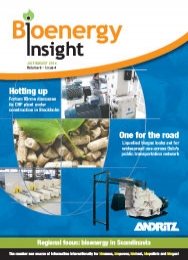
Volume 5, Issue 4
Published: August 1, 2014
EPA: Reduce methane at new landfills
In a move to reduce methane emissions from US landfills, the US Environmental Protection Agency (EPA) has proposed updates to air standards for new municipal solid waste (MSW) landfills. This announcement...
Hotting up
Fortum Värme, a subsidiary of Finland’s state-owned energy corporation Fortum co-owned together with the Swedish city of Stockholm, is constructing a combined heat and power (CHP) plant in Värtan....
Staying ahead of the game
Since it was opened in 1992, Lemvig Biogas has been the largest thermophilic biogas plant in Denmark. The plant, located in Lemvig town, is owned by 25 local farmers in a 100% privately owned cooperative....
One for the road
In Norway, the government is working towards carbon neutrality by the year 2050. This will be achieved in stages; first greenhouse gas (GHG) emissions will be slashed by 30% in 2020 before they are further...
Biogas in Scandinavia
The small northerly nations of Scandinavia tick many of the boxes for a strong biogas sector. Early adopters of carbon taxes? Check: 1990 for Finland, 1991 for Norway and Sweden, and 1992 for Denmark....
Material decisions for tanks
for tanks As energy prices continue to rise, the number of bioenergy plants across the world is increasing rapidly. However, design engineers are faced with a number of basic choices when it comes to starting...
Waste not, want not
In today’s climate there is a need to look at alternative ways to create low carbon, renewable energy. It is only in the past couple of years that the opportunities from biogas have become more apparent...
Sliding towards success
The 26-year-old boilers at Sandcastle Water Park in the UK posed a number of risks to the day to day operation of the business. Energy costs had risen to over 40% of operating overheads in the last five...
Upgrading for a better future
Sweden’s leading role in bioenergy production is set to be further enhanced with the news that Schmack Carbotech has been awarded a contract to design and build a new 2,000 Nm³/h processing...
Some like it hot
The advantages of thermophilic anaerobic digestion (AD) units (operating at around 50-60°C) over mesophilic AD units (operating at around 40°C) are already well-documented in terms of higher yields...
Increasing biogas output with liquid lime
Many manufacturing and municipal treatment plants produce acidic effluent from the production process. Some effluents must be treated extensively to remove contaminants before being safely discharged into...
SRC harvest technology: Still a pioneer's trade
Short rotation woody crops (SRWCs) such as poplar and willow present considerable potential as a biomass feedstock, and are extremely viable when established where conventional crops cannot be grown. The...
Combating climate change
Since March 2013, Finland-based heat and power producer Vaskiluodon Voima, a joint venture between EPV Energy and Pohjola Voima, has been operating the world’s largest biomass gasification plant....
On the double
It is of major advantage to compress straw into briquettes if it is to be used for boosting gas yield in biogas plants At Research Center Foulum, Aarhus University in Denmark, large quantities of straw,...
A fine example
Wood pellets have a tendency to break up when they are handled. Friction, caused during transportation, leads to the creation of a very fine wood powder and this represents a significant risk for fires...
No more agro-vation
When one renewable energy supplier wanted to utilise its ‘agro dust’ — the by-product of a central aspiration system in a biomass-fired power plant — it turned to Nawrocki Pelleting...
A solution to reliable baseload low carbon power
The transition from fossil fuels to low carbon emitting renewable energy for power production is necessary if we are going to mitigate the carbon effects on climate change. There are, however, serious...
On the horizon
The wood pellet industry in the US has seen rapid growth in the last decade. Exports of wood pellets from the US have doubled in the last two years alone, reaching over 3 million tonnes in 2013. But is...
Small but mighty
Pyrolysis is a thermochemical process in which a material is heated to high temperatures exceeding 400-500°C in the absence of oxygen. Fast pyrolysis accomplishes the heating of the material in about...























